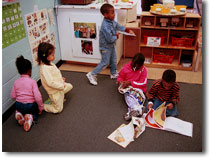 |
The Learning Ladder
|
| Module 6: Curriculum Planning | ||||
| Part 1 | Part 2 | Part 3 | Part 4 | Part 5 |
The Classroom Environment
 A classroom environment is very important to the learning experiences of young children. Most preschool programs divide their classrooms into different areas or learning centers. We define these by what children do in them.
A classroom environment is very important to the learning experiences of young children. Most preschool programs divide their classrooms into different areas or learning centers. We define these by what children do in them.
A typical classroom has the following areas:
The Block Area
 Most classrooms have a set of wood blocks. These blocks usually come in lots of different sizes and shapes. Most preschool classrooms keep the blocks in bookcases and arrange them by their size, with the smaller blocks on the top shelves and the bigger blocks in the lower shelves. When children play with blocks, they have a chance to explore such concepts as length, height, weight and balance. Blocks also allow children an opportunity to play
independently
or cooperatively in a group.
Most classrooms have a set of wood blocks. These blocks usually come in lots of different sizes and shapes. Most preschool classrooms keep the blocks in bookcases and arrange them by their size, with the smaller blocks on the top shelves and the bigger blocks in the lower shelves. When children play with blocks, they have a chance to explore such concepts as length, height, weight and balance. Blocks also allow children an opportunity to play
independently
or cooperatively in a group.
The Housekeeping Area
 The housekeeping area, or dramatic play area, is a part of the room set up like a house. The housekeeping area has furniture and props that support the children in playing make believe. During the year, teachers often make changes to the props they use in their housekeeping areas. For example, dress-up doctor and nurse clothing and a medical kit can change your housekeeping area to a doctor's office or hospital.
The housekeeping area, or dramatic play area, is a part of the room set up like a house. The housekeeping area has furniture and props that support the children in playing make believe. During the year, teachers often make changes to the props they use in their housekeeping areas. For example, dress-up doctor and nurse clothing and a medical kit can change your housekeeping area to a doctor's office or hospital.
The Art Area
 Children love to experiment and play with art materials. In most preschool classrooms, there is an area that is set up for art. There is usually a table to draw or paste on, a cabinet or bookcase filled with a variety of art materials, and at least one easel for painting.
Children love to experiment and play with art materials. In most preschool classrooms, there is an area that is set up for art. There is usually a table to draw or paste on, a cabinet or bookcase filled with a variety of art materials, and at least one easel for painting.
Computer Corner
 More and more preschool classrooms have computers for the children to use. Computers can help children to develop such skills as fine motor control and increase their abilities to follow directions. However, it is important that the computers have programs that are
developmentally appropriate.
More and more preschool classrooms have computers for the children to use. Computers can help children to develop such skills as fine motor control and increase their abilities to follow directions. However, it is important that the computers have programs that are
developmentally appropriate.
Sand and Water Tables
 Most classrooms have sand and water tables. These are places for children to learn concepts and ideas by doing. By playing with sand and pouring it from one container to another, children learn about weight and measurements like full and empty. When they blow bubbles or build a sand building with other children, they are also practicing social skills.
Most classrooms have sand and water tables. These are places for children to learn concepts and ideas by doing. By playing with sand and pouring it from one container to another, children learn about weight and measurements like full and empty. When they blow bubbles or build a sand building with other children, they are also practicing social skills.
Library or Book Corner
 Most classrooms have a special section of the room organized as a library area. Some teachers will add to this section by creating a writing center or a tape area where children can listen to books on tape. Inviting children to look and listen to books are important steps in developing their reading and writing skills.
Most classrooms have a special section of the room organized as a library area. Some teachers will add to this section by creating a writing center or a tape area where children can listen to books on tape. Inviting children to look and listen to books are important steps in developing their reading and writing skills.
| If you finished the reading, go to the activities for Part 2. | |
